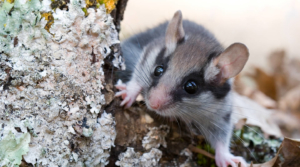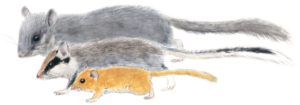THE FAMILY OF GLIRIDAE . . .
DORMOUSE MYOXUS GLIS
SLEEPING SQUIRREL (Myoxus glis) – The Dormouse
Physical Characteristics
- Size: 14-20 cm + 11-19 cm tail.
- Weight: Between 80 and 250 grams.
- Fur: The back and sides are uniformly chinchilla gray, sometimes with a reddish hue on the sides or black along the dorsal line.
- Features: A thin black ring around the eye, white cheeks and belly, long bushy tail with gray fur of equal length to the tip.
- Molars: Square, with a relatively flat but striped surface.
Lifestyle and Behavior
The dormouse (Myoxus glis) is a nocturnal rodent primarily found in broadleaf forests. It is mostly herbivorous but can also eat insects and small vertebrates. It is known for its hibernation behavior, which lasts for about 7 months (from October to April). It lives in small colonies or pairs and often builds its nests in tree cavities or abandoned nests. It is an excellent climber and rarely moves on the ground.
Reproduction and Life Cycle
- Breeding occurs between June and September, with a gestation period of 30-32 days.
- Number of offspring: From 1 to 11 per litter, usually between 4 and 6.
- Sexual maturity: Around 9-10 months.
- Life expectancy: Up to 9 years.
- Hibernation: From October to March-April.
Habitat and Geographic Distribution
The dormouse is found in Europe, primarily in broadleaf forests such as beech and oak. Its distribution spans southern Turkey, Corsica, Sardinia, Sicily, and many regions in Europe, excluding some areas of France and Scandinavia. It lives up to 1500 meters in altitude in the Alps and 2000 meters in the Pyrenees.
DORMOUSE MYOXIDAE

DORMOUSE MYOXUS GLIS & QUERCINO (Eliomys quercinus)
The quercino (Eliomys quercinus), a nocturnal rodent of the Myoxidae family, is often referred to as the “masked bandit” due to its characteristic black patch around its eyes. While some populations are still relatively well-preserved in certain areas, such as meadows or groves, this species is in strong decline across much of its natural distribution range. It is considered threatened with extinction and is listed on the IUCN Red List of Threatened Species.
Physical Characteristics
- Size: 15-20 cm in length, excluding the tail, and weighing between 60 and 140 grams.
- Fur: The quercino has a sharp contrast between its white belly and gray-brown back. Its long, bicolored tail flares at the tip.
- Distinctive Features: The black patch around its eyes gives it a “masked bandit” appearance. It has incisors for gnawing and sharp carnivorous teeth.
Lifestyle
- Nocturnal and Arboricolous: The quercino is both terrestrial and arboreal. During the day, it hides in a nest located in a tree hole, an old bird nest, or sometimes even in a human building. At night, it descends to the ground to forage for food.
- Hibernation: Like other European myoxidae (dormice, hazel dormice), the quercino hibernates and enters a deep dormancy during the winter. If disturbed during hibernation, it does not wake up.
Diet
- The quercino is omnivorous. It primarily feeds on fruit, berries, seeds, and insects, but can also consume small animals smaller than itself. It is also known to practice cannibalism, particularly during the mating season or at the end of hibernation, by devouring unfortunate rivals.
Habitat
- The quercino lives in various environments such as orchards, gardens, and parks, where it is more common than the hazel dormouse or the common dormouse. It also frequents barns and abandoned buildings.
Reproduction
- The female has one litter per year, typically between April and May. The gestation period lasts about 3 weeks, and the litter consists of 2 to 7 young. The young are born blind and hairless, measuring about 4 cm. Their fur develops rapidly, and the first distinguishing feature is a black line around their eyes.
- Sexual Maturity: They reach sexual maturity at around one year of age.
- Longevity: The quercino lives between 3 and 4 years in the wild.
Predators
- The main predators of the quercino are weasels, cats, and nocturnal birds of prey, such as owls and hawks.
Distribution
- The quercino is distributed throughout central Europe, from the western coast to the Urals. However, it is absent from Scandinavia, Great Britain, and the Balkans.
Status and Threats
- The quercino is experiencing a significant decline, for reasons that are still not fully understood.
- Pesticides and the degradation of natural habitats, such as groves and hollow trees, are factors contributing to its decline.
- Light pollution and its impact on nocturnal behavior are also potential factors, though they have not been studied in-depth.
HAZEL DORMOUSE MYOXUS GLIS
THE HAZEL DORMOUSE (Muscardinus avellanarius)
The hazel dormouse is a small mammal belonging to the rodent order and the Myoxidae family. Known for its compact size and graceful appearance, this animal is typical of woodland areas and environments with bushy vegetation in Europe.
Description
The hazel dormouse has a length between 14 and 16 cm, with its tail measuring about 7 cm, and weighs around 20-30 grams. It has reddish fur, a thick tail, and large black eyes, making it easily recognizable. Its size is similar to that of a mouse, but it has a more flexible and streamlined appearance.
Behavior
The hazel dormouse is nocturnal and arboreal, living in vegetated environments like thickets and bushes, where it moves nimbly on the thin branches of trees. During the day, it sleeps in a hidden nest among the leaves or in a tree trunk. It is known to remain motionless for hours, camouflaged like a dry leaf, when it senses danger.
In the autumn, it focuses on gathering hazelnuts and acorns, storing food and fat for the winter. At this point, it builds a nest on the ground, under dead leaves, where it will hibernate through the winter. Its body temperature drops significantly, entering a state of hibernation interrupted by brief awakenings.
Diet
The hazel dormouse primarily feeds on seeds, berries, flowers, buds, and insects. In autumn, it also consumes hazelnuts and acorns to prepare for hibernation. Its diet varies depending on the season and the availability of food.
Reproduction
The female hazel dormouse has one litter per year, which can range from 2 to 7 young. The gestation period lasts about 3 weeks, and the young are born blind and pink, but they develop rapidly. They reach sexual maturity after about one year.
Predators
The main predators of the hazel dormouse include martens, cats, and nocturnal birds of prey, such as owls and tawny owls, which hunt it in its natural habitats.
Distribution
The hazel dormouse is found throughout most of Europe but is absent in the more northern regions and the Iberian Peninsula. It is the only myoxide species present in England.
Conservation Status
The hazel dormouse is a species in decline in many areas due to habitat loss and pesticide use. It is a protected species in many European countries, and its protection is crucial to ensure the conservation of existing populations.
Fun Facts
The name “hazel dormouse” likely derives from its musky scent. In the past, it was also called the “golden rat” or “croque-noix” due to its habit of eating hazelnuts.
In Summary
The hazel dormouse is a small, nocturnal, and graceful mammal that plays an important role in its ecosystem. Its presence in woodlands and gardens is an indicator of a healthy and well-preserved environment.





